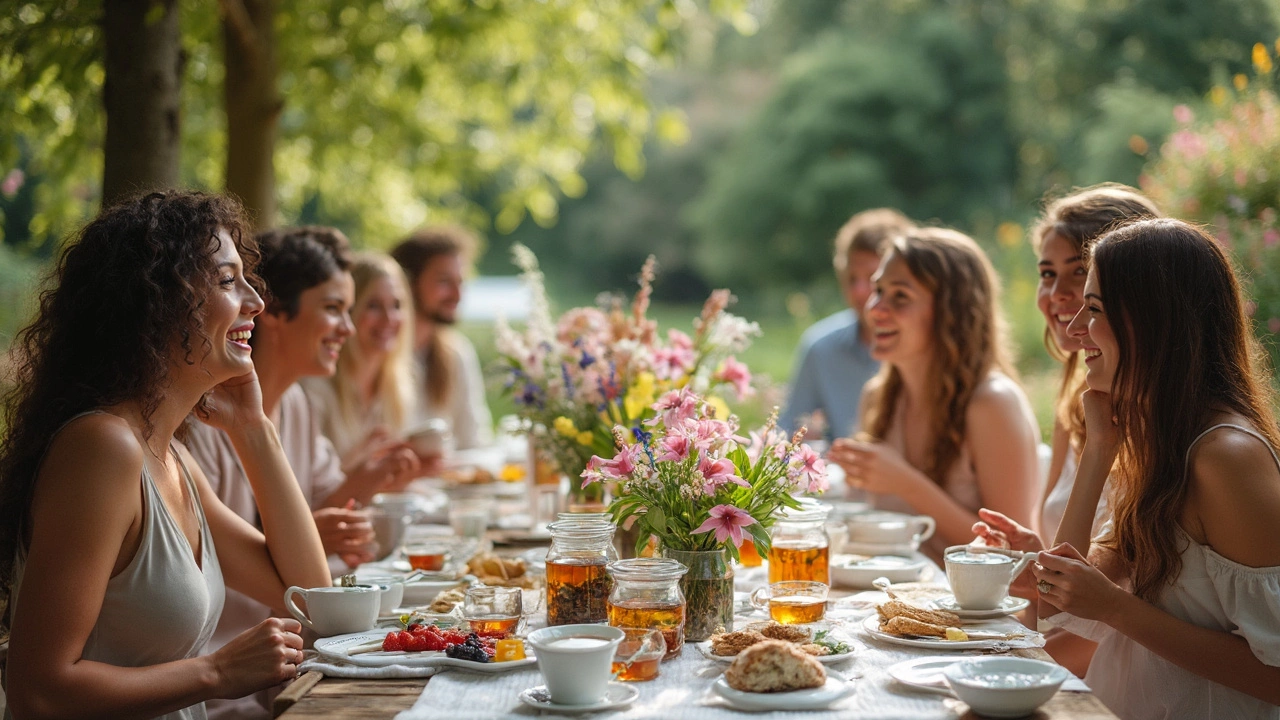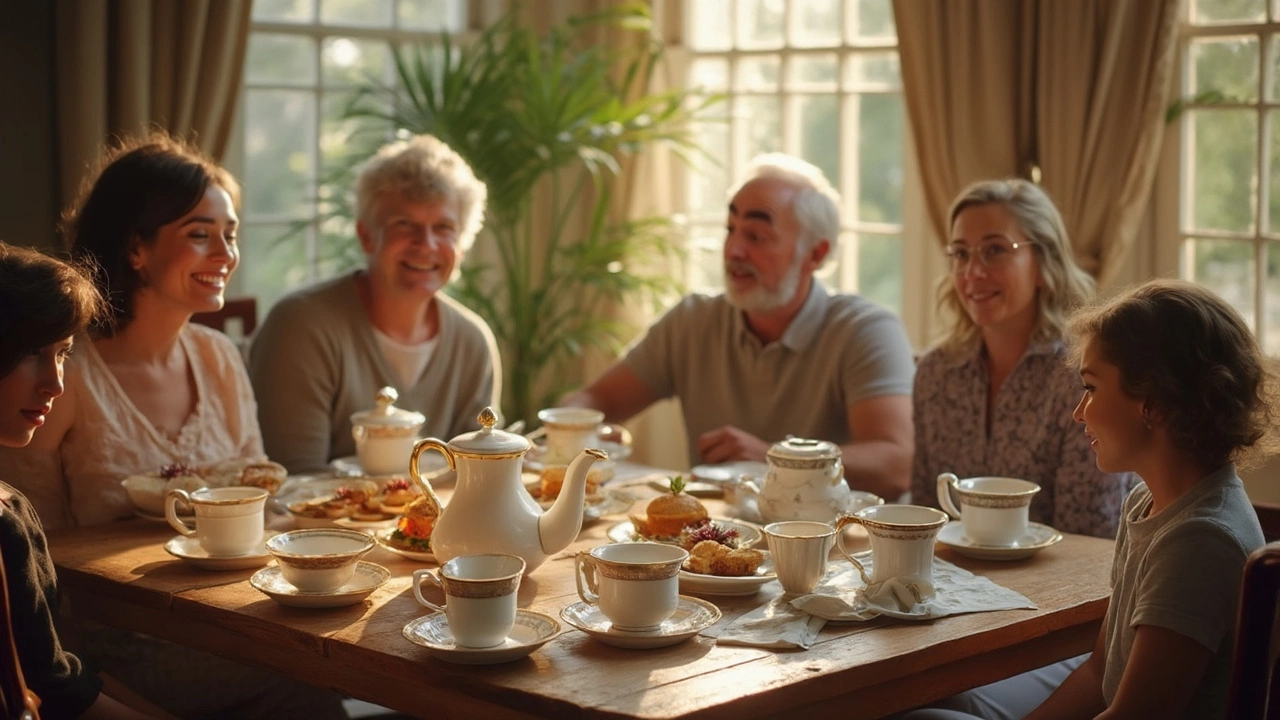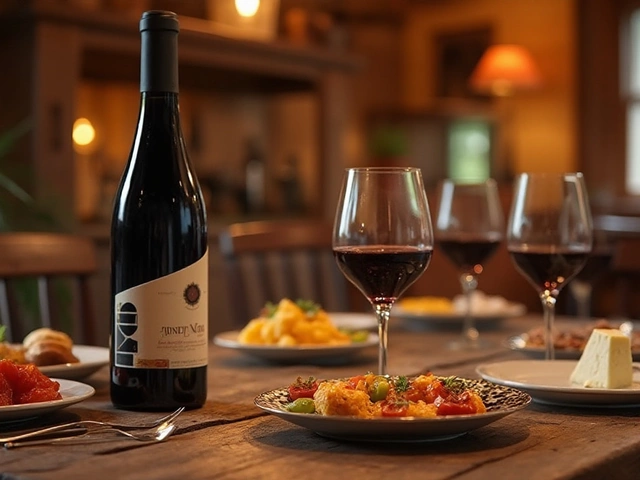If you want your tea tasting to actually taste good—not just look pretty for Instagram—what you serve alongside the tea makes a big difference. It’s not just about fancy cookies and little cakes. The right food can actually make tea flavors pop and help prevent taste overload. No one remembers sipping their fifth cup of black tea, but they’ll remember a killer scone or a fresh cucumber bite that made the next sip stand out.
Think beyond tradition. Sure, buttery shortbread or sweet pastries work, but savory snacks like cheese, olives, or even roasted nuts can be game changers. Start with foods that don’t overpower—the goal is to highlight the tea, not mask it. You don’t need anything expensive or complicated. A piece of fresh fruit or some good bread will go farther than you think.
- Building Your Tea Lineup
- Balancing the Food Menu
- Classic Pairings That Always Work
- Avoiding Common Pitfalls
- Tips for a Memorable Experience
- Making It Easy and Enjoyable
Building Your Tea Lineup
The right tea lineup makes or breaks a tea tasting. Tossing random tea bags in a row just doesn’t cut it. Start by picking three to five types, so people can compare but not get overwhelmed. Mixing up the tea categories keeps everyone’s taste buds interested and prevents that “all teas taste the same” feeling by the end. You’ll get the best results if you cover the main categories: white, green, oolong, black, and maybe a wild card like pu-erh or herbal, depending on your vibe.
- If you’re going for educational, pick classic examples: a Chinese Dragonwell for green, a Darjeeling for black, and so on.
- Around 6-8g of loose tea is usually enough for one teapot or a round of tasting cups.
- Most tea tastings roll from lightest (like white or green) to heaviest (like black or aged pu-erh). This helps the flavors build rather than clash.
Here’s a simple lineup you could try for beginners and longtime tea lovers alike:
- White Tea: Silver Needle or White Peony
- Green Tea: Dragonwell (Longjing) or Sencha
- Oolong: Tieguanyin or Da Hong Pao
- Black Tea: Assam or Darjeeling
- Herbal: Chamomile or Peppermint (optional, especially good for caffeine-free guests)
Temperature and steep time matter more than you think. Most green and white teas need water cooled to 70–80°C (158–176°F), while black teas usually take boiling water. If you use the wrong temp, you’ll either burn the leaves or miss the good flavors. This chart gives you an idea of where to start for each type:
| Tea Type | Water Temperature | Steep Time |
|---|---|---|
| White | 75°C (167°F) | 2–3 min |
| Green | 80°C (176°F) | 1–2 min |
| Oolong | 90°C (194°F) | 2–4 min |
| Black | 100°C (212°F) | 3–5 min |
| Herbal | 100°C (212°F) | 5+ min |
If you want people to really get into what they’re sipping, set up your tasting so there’s some structure. Write down the name of each tea tasting on cards, give everyone a sheet to jot notes, and chat about which flavors jump out to them in each one. You don’t need to be a sommelier—just pay attention to what you like and what’s different between each cup. It keeps things simple and fun.
Balancing the Food Menu
The snacks you choose can make or break your tea tasting vibe. Don’t pile the table with random options—think about how flavors mix with the teas on your list. Mild foods support the tea, not overshadow it. Steer clear of spicy wings or super garlicky dips, unless you want your palate shot before you even get through the oolongs.
Here’s a quick cheat sheet for matching food with common types of tea:
- Green teas: Fresh flavors work best here. Think cucumber sandwiches, goat cheese, or strawberries.
- Black teas: Heartier foods stand up well—cheddar, scones, smoked salmon, or even chocolate.
- Oolong teas: Slightly nutty snacks like almonds, apricot jam, or aged cheeses are winners.
- Herbal teas: Light, slightly sweet treats like shortbread, dried fruit, or honeyed nuts fit the bill.
If you want hard numbers, a 2022 survey by the Specialty Tea Institute showed that 82% of hosts noticed better feedback from guests when pairing teas with simple, complementary foods rather than just sweets.
It’s all about finding balance. You want foods that cleanse the palate, not leave an aftertaste. Fresh fruit, plain crackers, and even cold roasted veggies play this role really well—no chef skills needed. As Rebekah Smith, a well-known tea educator, puts it:
"Your snacks shouldn't fight your tea, they should set the stage for it. Less is usually more."
Still not sure what to serve? This basic table sorts snacks by tea type and taste notes for easy planning:
| Tea Type | Good Snack Pairings | Avoid |
|---|---|---|
| Green | Cucumber, light cheese, berries | Barbecue chips, strong garlic breads |
| Black | Cheddar, scones, smoked salmon | Super spicy salsa, pickle-heavy dishes |
| Oolong | Roasted nuts, mild aged cheese | Sweet frosting, heavy cream pastries |
| Herbal | Shortbread, honey walnuts, melon | Strong garlic, onion-heavy dips |
If your group has special diets—gluten-free, dairy-free, or vegan—just swap in easy alternatives. Rice crackers, hummus, or dried mango slices keep things simple. The main rule? Don’t overthink it. The best pairings are ones people actually want to eat between sips.
Classic Pairings That Always Work
Everybody talks about those little cucumber sandwiches and buttery shortbread biscuits for a reason: they just work with tea. Still, you don’t need to stick to the same old snacks. Certain flavors will reliably make your tea tasting stand out. It’s all about balance—matching the tea’s style with simple food that either highlights or softens its taste.
Here’s what actually pairs well, tried and tested:
- Green teas: These are fresh and sometimes grassy. Go for light foods like steamed dumplings, sushi rolls, or even edamame. One fun fact—Japanese sencha is often served alongside rice crackers or pickled veggies because the salt lifts the green tea’s flavor.
- Black teas: Think breakfast fare—think scones, clotted cream, or even a classic ham and cheese sandwich. Assam and Ceylon teas, with their stronger flavors, hold up well to rich bites. Chocolate also pairs surprisingly well (especially a basic dark chocolate square).
- Oolong teas: Semi-oxidized teas love a little fat. Good bets are roasted nuts, mild cheeses, or simple fruit like peach slices. Taiwanese oolong and dried mango is a combo that just works.
- Herbal teas: These are often fruity or floral, so keep snacks simple. Lemon pound cake, honey cookies, or a handful of dried berries won’t clash. Anything too spicy or intense will kill the vibe.
- White teas: Very delicate, so you want something that doesn’t overpower them. Thin tea biscuits, melon slices, or even just a good old butter cracker let these subtle teas shine.
It sounds fussy, but honestly, you don’t need a mountain of snacks. Just a small plate with a few options is enough. Keep it low-key and your tea (and your guests) will thank you.

Avoiding Common Pitfalls
It’s easy to get tripped up at a tea tasting if you don’t plan a bit. Common mistakes can leave guests yawning or even ruin the flavors you’re aiming to show off. Here’s what most people get wrong—and how to dodge those slip-ups:
- Serving too many teas. More isn’t always better. If you put out more than five varieties, taste buds get numb, and people can’t tell one from another. Stick to three to five teas for a session.
- Mismatch between food and tea. Super spicy, greasy, or garlicky foods will wreck the subtle notes in most teas, especially white or green ones. Keep snacks simple, and save the loaded nachos for another day.
- Ignoring water. Tea dries your mouth, and switching between teas without water will blunt each new sip. Offer still water and remind guests to cleanse their palate between teas.
- Unclear tasting order. Jumping from strong black teas to light white ones doesn’t make sense. Go from light to strong, just like you would with wine. If you mix it up, delicate teas taste bland after heavy ones.
- Leaving out the context. People remember stories. Point out fun facts or origins about each tea. For example, point out how Darjeeling is often called the "champagne of teas"—that detail sticks.
Here’s a quick snapshot of problems vs. fixes to keep your tea tasting on track:
| Problem | Simple Fix |
|---|---|
| Too many teas | Limit to 3-5 types |
| Overpowering food | Stick with mild, neutral snacks |
| No palate cleansers | Have fresh water available |
| Poor tasting order | Go from lightest to boldest tea |
| Lack of engagement | Share quick stories or facts |
If you keep your tea tasting tight and thoughtful, everyone leaves with a better sense of what makes each sip stand out. Skip the overkill—nobody’s asking for a marathon.
Tips for a Memorable Experience
The best tea tasting sessions are relaxed, hands-on, and just a little bit unexpected. You want your guests to remember more than just the teas—they should leave talking about the fun and vibe of the whole thing. First off, always serve water between tastings. It resets tastebuds and keeps flavors from blending together. Cool, filtered water works way better than sparkling, since bubbles can mess with the subtler notes in tea.
Don't skip out on sharing fast, interesting facts about each tea. Things like, “Did you know white tea is barely processed at all?” or “Green tea can actually taste sweet if you brew it at a lower temp.” A bit of trivia gives everyone something to talk about, especially folks new to tea.
Set out neutral foods—even basic crackers or plain bread work. These help clear the mouth between sips, letting everyone actually taste the differences. If you add jams or spreads, label them so no one grabs something weird with a delicate tea. Pro tip: avoid anything too greasy or spicy. They’ll dominate your palate for way too long.
- Keep portions small, so guests can pace themselves.
- Offer tasting cards for guests to jot down what they notice. You don’t have to get fancy—simple note sheets or index cards do the trick.
- Arrange teas from lightest (like white or green) to strongest (think black or oolong) to prevent strong teas from taking over early on.
- Add an ice breaker: have everyone pick their favorite tea at the end. It sparks conversation and gets everyone engaged.
Try not to cram the table with tons of food or decorations. You want the focus on the tea tasting, not on a cluttered setup. Real talk: a clean, uncluttered space helps people relax and actually enjoy what’s in their cup.
Music helps too—go for mellow background tunes that don’t distract. And when in doubt, remember this: if everyone’s laughing and comparing what they taste, you’re doing it right, even if someone pronounces Lapsang Souchong wrong. That’s half the charm.
Making It Easy and Enjoyable
No one wants to stress over a tea tasting—not you and not your guests. The best way to pull off a relaxed, fun session is to keep things simple. Forget about matching teacups or buying ten kinds of rare loose leaf. Pick a few solid teas and serve them with snacks that fit, and people will remember the vibe, not whether your napkins matched.
If you want to look like a pro without acting like a stuffy tea snob, set up a self-serve area. Line up your teas, have some hot water ready, and let your guests pour their own. That takes the pressure off you and gives everyone a chance to go at their own pace. You don’t even need a fancy kettle—an electric kettle does the job. Bonus tip: label each tea and each snack. Even regulars get the munchies mixed up.
Wondering how long a typical session goes? Keep it to about 60-90 minutes. Most people lose focus after three or four kinds of tea, so don’t overdo it. If you’re inviting a mix of newbies and tea nerds, make sure all your descriptions are easy to understand—skip the poetic tasting notes and just say what the tea tastes like.
Here’s a quick list to keep it smooth and simple:
- Limit it to 3 or 4 teas, plus easy snacks like fruit, cheese, or biscuits.
- Have plenty of plain water on hand, especially if you’re serving strong teas.
- Give everyone a notepad or scrap of paper for jotting down favorites. You’ll get more conversation that way.
- Skip the hard rules—let people mix, match, and double dip snacks if they want.
Want to know what snacks are actually popular at tea tastings? Check this:
| Snack | Popularity at Tastings (%) |
|---|---|
| Scones | 80 |
| Cucumber Sandwiches | 65 |
| Shortbread | 70 |
| Mixed Nuts | 55 |
| Fresh Fruit | 75 |
Here’s the bottom line: people just want good tea, tasty bites, and zero pressure. You don’t need a silver teapot or endless etiquette rules. The best tasting is the one where everyone heads home happy and maybe just a bit caffeinated.


